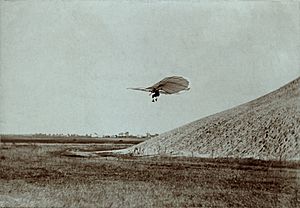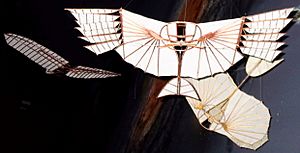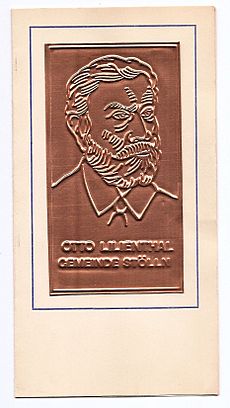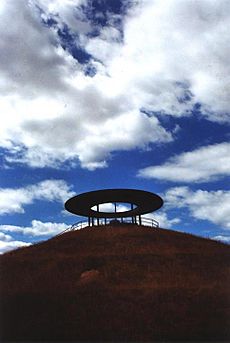Otto Lilienthal facts for kids
Quick facts for kids
Otto Lilienthal
|
|
|---|---|
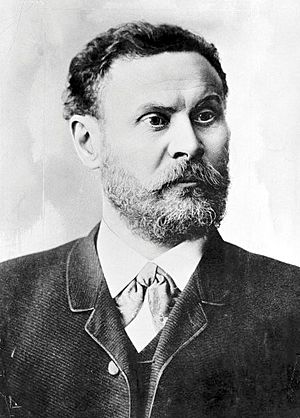
Lilienthal, c. 1895
|
|
| Born |
Karl Wilhelm Otto Lilienthal
23 May 1848 Anklam, Prussia
|
| Died | 10 August 1896 (aged 48) |
| Cause of death | Cervical fracture sustained in a hang glider crash |
| Resting place | Lankwitz Cemetery, Berlin |
| Nationality | Prussian, German |
| Education | College Mechanical Engineer Major |
| Occupation | Engineer |
| Known for | Successful gliding experiments |
| Height | 1.88 m (6 ft 2 in) |
| Spouse(s) |
Agnes Fischer
(m. 1878–1896) |
| Children | 4 |
| Relatives | Gustav Lilienthal (brother) |
Karl Wilhelm Otto Lilienthal (born May 23, 1848 – died August 10, 1896) was a German pioneer in aviation. He was known as the "flying man" because he was the first person to make many successful and well-documented flights using gliders. This proved that "heavier-than-air" machines could actually fly.
Newspapers and magazines showed pictures of Lilienthal gliding. This helped people and scientists believe that flying machines could become real. Lilienthal's work also led to the design of the modern airplane wing. His flights in 1891 are seen as the start of human flight. His "Lilienthal Normalsegelapparat" is thought to be the first airplane made in large numbers. This made his company, Maschinenfabrik Otto Lilienthal in Berlin, the world's first airplane production company.
Otto Lilienthal is often called the "father of aviation" or "father of flight." Sadly, on August 9, 1896, his glider lost control and fell about 15 meters (50 feet). He broke his neck and passed away the next day.
Contents
Early Life and Dreams of Flight
Lilienthal was born on May 23, 1848, in Anklam, a town in what was then Prussia, Germany. His parents were Gustav and Caroline. Otto and his brother Gustav (born 1849) were very close and worked together on many projects throughout their lives.
From a young age, Otto and Gustav were fascinated by birds and how they flew. They even tried to make their own wings to strap on, but they couldn't fly with them. Otto went to a technical school and later became a professional design engineer.
In 1867, Lilienthal started serious experiments on how air creates force, which is important for flight. He paused his work to serve in the Franco-Prussian War. After the war, he worked for engineering companies and even got his first patent for a mining machine. He then started his own company that made boilers and steam engines. This business success gave him the money to focus on his dream of flying.
On June 6, 1878, Lilienthal married Agnes Fischer. They both loved music. They lived in Berlin and had four children. In 1889, Lilienthal published his famous book, Birdflight as the Basis of Aviation, which shared his ideas about how birds fly.
Pioneering Flight Experiments
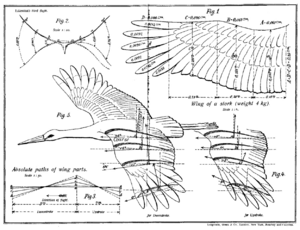
Lilienthal's biggest achievement was his work on flying machines that were heavier than air. He made his flights from an artificial hill he built near Berlin. He also used natural hills, especially in the Rhinow area.
In 1894, Lilienthal filed a U.S. Patent for his glider. It showed pilots holding a "bar" to control the glider. This idea is still used in modern hang gliders and ultralight aircraft today. Working with his brother Gustav, Lilienthal made over 2,000 flights in his gliders between 1891 and 1896. His first glider was called the Derwitzer Glider. In total, he spent about five hours flying.
In 1891, Lilienthal started with short jumps and flights of about 25 meters (82 feet). He learned to use the updraft (rising air) from a 10 m/s wind against a hill to stay in the air without moving forward. This allowed photographers to get the best pictures! By 1893, in the Rhinow Hills, he could fly as far as 250 meters (820 feet). This was a record that no one, not even Lilienthal himself, broke before his death.
Lilienthal carefully studied how birds, especially storks, flew. He used special diagrams to understand the aerodynamics (how air moves around things) of their wings. He did many experiments to collect reliable information about flight.
Glider Designs
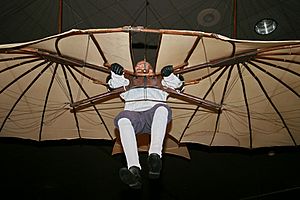
During his short time flying, Lilienthal designed many different types of aircraft. These included a dozen monoplanes (with one set of wings), wing-flapping aircraft, and two biplanes (with two sets of wings). His gliders were made to balance weight carefully for stable flight.
Lilienthal controlled his gliders by shifting his body to change the center of gravity. This is similar to how modern hang gliders are controlled. However, his gliders were hard to steer and often wanted to nose-dive. It was difficult to recover from this position because he held the glider by his shoulders. This meant he could only move his legs and lower body, which limited how much he could shift his weight.
Lilienthal tried many ways to make his gliders more stable. He made a biplane, which had shorter wings for the same wing area. He also added a hinged tail that could move up to help him land more smoothly. He even thought that flapping wings, like birds have, might be needed for powered flight and had started working on such a machine.
Flight Test Locations
Lilienthal made his first glider flights in mid-1891 at a place called "Windmühlenberg" near the villages of Krielow and Derwitz, west of Potsdam.
In 1892, Lilienthal trained at a hill called "Maihöhe" in Steglitz, Berlin. He built a 4-meter (13-foot) tall shed shaped like a tower on top of it. This gave him a 10-meter (33-foot) high "jumping off" spot. The shed also stored his gliders.
From 1893, Lilienthal also flew in the "Rhinower Berge" (Rhinow Hills), at "Hauptmannsberg" near Rhinow, and later, in 1896, at "Gollenberg" near Stölln.
In 1894, Lilienthal built his own artificial hill near his home in Lichterfelde. He called it Fliegeberg, which means "Fly Hill." This hill was 15 meters (49 feet) high and allowed him to launch his gliders into the wind no matter which direction it was blowing. Many people came to watch his exciting experiments.
In 1932, the Fliegeberg was turned into a memorial for Lilienthal. A small temple-like building was placed on top of the hill. Inside, there is a silver globe with details about famous flights. Lilienthal's brother Gustav attended the ceremony on August 10, 1932, 36 years after Otto's death.
Becoming Famous Worldwide
News of Lilienthal's flights spread quickly in Germany and around the world. Pictures of him flying appeared in science magazines and popular publications. Famous photographers like Ottomar Anschütz took his pictures. He soon became known as the "father of flight" because he was the first to successfully control a heavier-than-air aircraft in sustained flight.
Lilienthal was a member of a group called the Verein zur Förderung der Luftschifffahrt (Society for the Promotion of Airship Travel). He often wrote about his experiences in their journal. These articles were translated and read in the United States, France, and Russia. Many people from all over the world came to visit him, including Samuel Langley from the United States, Nikolai Zhukovsky from Russia, and Percy Pilcher from England. Zhukovsky even said that Lilienthal's flying machine was the most important invention in aviation. Lilienthal also wrote letters to many other flight pioneers.
His Final Flight
On August 9, 1896, Lilienthal went to the Rhinow Hills, as he often did on weekends. It was a sunny and pleasant day. His first flights were successful, reaching distances of 250 meters (820 feet) in his normal glider.
During his fourth flight, something went wrong. Lilienthal's glider suddenly pitched forward, pointing quickly towards the ground. He had faced this problem before and it was hard to fix because he had to shift his weight. His attempts to regain control failed, and he fell from a height of about 15 meters (50 feet) while still in the glider.
Paul Beylich, Lilienthal's glider mechanic, took him by horse-drawn carriage to Stölln. A doctor examined him there. Lilienthal had broken his third neck bone and soon lost consciousness. Later that day, he was taken by train to Berlin and the next morning to a famous surgeon's clinic. Lilienthal passed away there a few hours later, about 36 hours after the crash.
There are different stories about Lilienthal's last words. A popular saying, carved on his tombstone, is "Sacrifices must be made!" However, the director of the Otto Lilienthal Museum doubts these were his actual last words. Otto Lilienthal was buried in the Lankwitz public cemetery in Berlin.
Lilienthal's Lasting Legacy
Lilienthal's research was well known to the Wright brothers, who are famous for making the first successful airplane flight. They said he was a major inspiration for their own work in manned flight.
Before it closed in 2020, Berlin's busiest airport, Berlin Tegel "Otto Lilienthal" Airport, was named after him.
In September 1909, Orville Wright visited Germany to show off his airplane. He went to see Lilienthal's widow and, on behalf of himself and his brother Wilbur, thanked Lilienthal for his important influence on aviation and their own early experiments.
In 1972, Lilienthal was added to the International Air & Space Hall of Fame, which honors important people in aviation. In 2013, Flying magazine ranked Lilienthal No. 19 on their list of the "51 Heroes of Aviation."
A German Air Force tanker plane, an Airbus A310 MRTT, was named "Otto Lilienthal" in his honor. The Lilium Jet, a new type of electric vertical take-off and landing (eVTOL) airplane, and the company that designed it, Lilium GmbH, were also named after him.
An exact copy of the Normalsegelapparat, made by the Otto Lilienthal Museum, has been tested in a wind tunnel and in flight by the German Aerospace Center. The tests showed that the glider was stable and could be flown safely.
Images for kids
Lilienthal often had photographers with him, like Ottomar Anschütz. He also took his own photos of his flying machines. There are at least 145 known photographs that show his test flights, and many are very clear. All of them can be seen online at the Otto Lilienthal Museum website. Sadly, the original photo negatives, which were kept in a museum in Munich, were destroyed during World War II.
See also
 In Spanish: Otto Lilienthal para niños
In Spanish: Otto Lilienthal para niños
- Lilienthal Gliding Medal
- Otto Lilienthal Museum
- Aviation history
- Albrecht Berblinger
- Abbas Ibn Firnas
- George Cayley
- Jean-Marie Le Bris
- John Joseph Montgomery
- German inventors and discoverers


